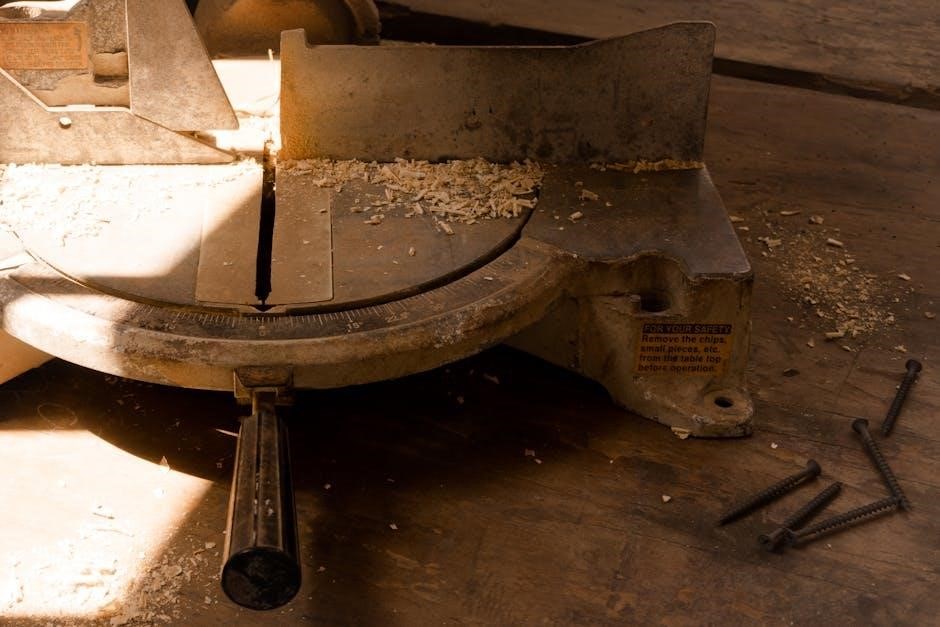
The process of adding a manual safety to a Glock pistol enhances its safety features for users seeking an extra layer of control. This modification involves installing a thumb safety lever, which prevents unintended discharges. The Tactical Safety System for Glock by RDIH is a popular solution, designed for stock pistols only. Proper installation ensures reliability and functionality, with professional services available for those seeking expert results.
1.1 Overview of Glock Safety Features
Glock pistols are renowned for their safety features, including a trigger safety, firing pin safety, and drop safety. These mechanisms prevent accidental discharges without requiring a manual safety lever. The trigger safety ensures the pistol fires only when the trigger is fully pressed, while the firing pin safety blocks the striker unless the trigger is pulled. These features provide reliable, passive protection, making Glocks safe and user-friendly by design.
1.2 Importance of Manual Safety for Glock Pistols
The addition of a manual safety to a Glock pistol provides an extra layer of control, particularly during high-stress situations. While Glocks are designed with passive safety features, a manual safety offers an additional safeguard against accidental discharges. This is especially valued by users with military or law enforcement backgrounds, who may prefer the tactile feedback of a thumb safety. It enhances safety and user confidence, particularly in professional or defensive contexts.

Tools and Parts Required for Installation
The process requires a Manual Safety Kit with a Thumb Safety Lever, Detent Plate, Spring, and Trigger Bar Guide. Essential tools include punch tools, screwdrivers, and specialized gunsmithing tools for precision.
2.1 Glock Manual Safety Kit Components
The Glock Manual Safety Kit includes a Thumb Safety Lever, Detent Plate, Spring, and Trigger Bar Guide. These components ensure proper function and reliability. The kit also provides instructional sheets for guidance. Each part is designed to integrate seamlessly with the Glock’s existing mechanism, maintaining its performance while adding a manual safety feature. The components are crafted for durability and precision, ensuring a secure and reliable safety system.
2.2 Essential Gunsmithing Tools for the Process
Installing a manual safety on a Glock requires specific tools for precision and safety; These include punch tools, specialized screwdrivers, and a Cominolli jig for accurate slot cutting. Additionally, gunsmithing hammers, files, and measuring tools are necessary for fitting and adjusting components. Proper tools ensure the modification is done correctly, maintaining the pistol’s reliability and functionality. These tools are essential for a successful and safe installation process.

Step-by-Step Installation Process
The installation begins with removing the magazine and ensuring the pistol is unloaded. Next, the slide is removed, and the trigger mechanism is accessed. Using a jig, a precise slot is cut for the safety lever. The thumb safety and detent plate are then installed, followed by reassembling and testing the trigger function to ensure proper operation. Each step requires careful execution to maintain reliability and safety.
3.1 Preparing the Glock Pistol for Modification
Begin by ensuring the pistol is unloaded, with the magazine removed and chamber cleared. Remove the slide and disassemble the frame. Punch out the trigger pins and carefully extract the trigger mechanism. Clean the area around the slide stop to ensure a smooth process. Use a jig or guide to mark the location for the safety lever slot. Follow the manufacturer’s instructions to avoid damaging internal components. Proper preparation is key to a successful installation.
3.2 Cutting the Slot for the Safety Lever
Use a jig or guide to precisely mark the slot location on the frame. Employ a milling bit or precision saw to carefully cut the slot, ensuring it aligns with the detent plate. Maintain the correct depth and width to avoid compromising the frame’s structural integrity. Wear safety glasses and work slowly to achieve a clean, accurate cut. Follow the manufacturer’s instructions to prevent errors during this critical step.
3.3 Installing the Thumb Safety Lever and Detent Plate
Align the thumb safety lever with the slot, ensuring proper fitment. Secure it using the provided screws, tightening evenly. Next, install the detent plate into its designated area, ensuring it aligns with the lever. Use a screwdriver to tighten the detent plate screws firmly. Finally, test the lever’s movement to ensure smooth operation and proper engagement with the detent. Verify that the safety functions correctly before proceeding.

Safety Testing and Validation
After installation, conduct thorough safety testing to ensure the manual safety functions correctly. Engage and disengage the lever repeatedly, then perform dry-fire tests to verify trigger operation. Always handle the firearm safely during testing.
4.1 Testing the Manual Safety Functionality
After installation, testing the manual safety is critical. Engage and disengage the lever repeatedly to ensure smooth operation. Conduct dry-fire tests with the safety on to confirm the trigger doesn’t release the striker. Verify that the safety does not interfere with the pistol’s natural function. Testing must be done in a controlled environment, following all safety protocols. This step ensures the manual safety enhances control without compromising reliability.
4.2 Ensuring Proper Trigger Mechanism Operation
After installing the manual safety, test the trigger mechanism to ensure it functions correctly. Perform dry-fire tests with the safety off to confirm smooth trigger pull and reset. Verify that the trigger does not bind or hesitate, and the striker releases consistently. If any issues arise, consult a professional gunsmith or armorer to inspect and adjust the mechanism. Proper operation ensures both safety and reliability.

Professional Installation Services
Professional installation services for Glock manual safety start at $138, including slot cutting and lever installation. Services like Ten Ring Precision ensure precise and reliable modifications for safety.
5.1 Cost and Labor Involved in Professional Installation
Professional installation of a Glock manual safety typically costs $138, covering parts and labor. This includes cutting the slot for the safety lever and installing the device. Services like Tarnhelm Supply charge $125 plus shipping, ensuring a precise and reliable modification. Costs vary slightly depending on the provider, but the process is generally affordable for those seeking expert installation.
5.2 Recommended Gunsmiths and Services
For a reliable manual safety installation, consider services like Ten Ring Precision and Tarnhelm Supply. These reputable providers offer expert labor and genuine parts. Ten Ring Precision charges $138, while Tarnhelm Supply offers the service for $125 plus shipping. Both ensure precision and safety, making them top choices for Glock owners seeking professional modifications.

DIY vs. Professional Installation
DIY installation offers cost savings and personal satisfaction but requires precise tools and expertise. Professional services ensure reliability and safety, recommended for optimal results.
6.1 Pros and Cons of DIY Installation
DIY installation saves money and offers a sense of accomplishment but requires precision and expertise. It involves tools like punch tools and specialized jigs, such as the Cominolli jig, to ensure accuracy. However, improper installation can compromise reliability and safety, potentially leading to unintended discharges. DIY is best for experienced gunsmiths, while others may risk voiding warranties or causing mechanical issues.
6.2 Risks of Improper Installation
Improper installation of a manual safety can lead to critical issues, such as unintended discharges or malfunctioning triggers. If the thumb safety lever or detent plate is misaligned, the pistol may fail to fire when needed or discharge accidentally. Additionally, altering the firing mechanism without proper expertise can void the warranty and render the firearm unsafe, posing serious risks to the user and others.

Advantages and Risks of Adding a Manual Safety
Adding a manual safety enhances control during high-stress situations but may compromise reliability if improperly installed, potentially affecting the pistol’s functionality and safety mechanisms.
7;1 Enhanced Control During High-Stress Situations
A manual safety provides an additional layer of control, reducing the risk of accidental discharges during high-pressure scenarios. This is particularly beneficial for users with military or law enforcement backgrounds, who may prefer the tactile reassurance of a thumb safety. By adding this feature, shooters gain enhanced situational awareness and precision, ensuring their firearm operates safely under stress. This modification is ideal for those prioritizing absolute control;
7.2 Potential Impact on Reliability

Adding a manual safety to a Glock can introduce potential reliability concerns if not installed correctly. The Tactical Safety System by RDIH requires a stock pistol with no alterations to the firing mechanism. Improper installation or modifications may lead to unintended discharges or functional issues. Regular testing and maintenance are crucial to ensure the safety does not compromise the pistol’s performance. Always follow professional guidelines to maintain reliability and safety.

Aftermarket Manual Safety Solutions
Popular manual safety solutions include the RDIH Tactical Safety System and Glock Manual Safety Kit, offering enhanced control and compatibility with specific Glock models for improved functionality and safety.
8.1 Popular Manual Safety Kits for Glock Pistols
The RDIH Tactical Safety System and Cominolli Manual Safety Kit are highly regarded aftermarket solutions. These kits include components like the thumb safety lever, detent plate, and spring, designed to integrate seamlessly with stock Glock pistols. They offer enhanced control and reliability, with clear installation instructions for both DIY enthusiasts and professional gunsmiths, ensuring safe and effective functionality.
8.2 Compatibility with Different Glock Models
Popular manual safety kits like the RDIH Tactical Safety System are compatible with most Glock models, including Gen 3 and Gen 4 pistols. These kits are designed to fit stock Glock pistols with a slide width of 25.5 mm. However, some kits may not be compatible with Gen 5 Glocks or altered firing mechanisms. Always verify compatibility before purchasing or installing a manual safety kit for your specific Glock model.
The addition of a manual safety to a Glock pistol offers enhanced control and peace of mind for users. Proper installation ensures reliability, making it a valuable modification for those prioritizing safety and functionality.
9.1 Final Thoughts on Glock Manual Safety Installation
Installing a manual safety on a Glock offers enhanced control and peace of mind for users. Kits like the Tactical Safety System by RDIH provide reliable solutions. However, proper installation is crucial to maintain functionality. While some prefer the added security, others argue it may compromise the Glock’s simplicity. Weighing pros and cons is essential for a decision that meets individual needs and ensures safety.
9.2 Recommendations for Glock Owners
Glock owners considering a manual safety should consult professional gunsmiths to ensure proper installation and reliability. Services like Ten Ring Precision and Tarnhelm Supply offer expert solutions. Before modifying, assess your needs and weigh the benefits against potential drawbacks. Always follow safety protocols and test functionality post-installation. For optimal results, choose reputable kits like the RDIH Tactical Safety System, ensuring compatibility with your Glock model.